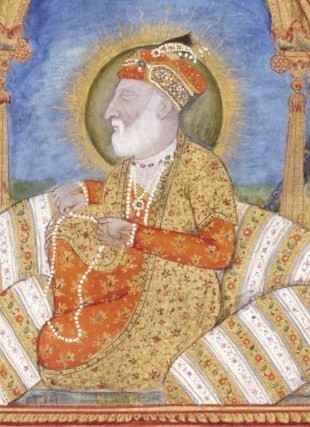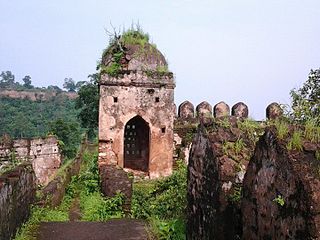Related Research Articles

Jharkhand is a state in eastern India. The state shares its border with the states of West Bengal to the east, Chhattisgarh to the west, Uttar Pradesh to the northwest, Bihar to the north and Odisha to the south. It has an area of 79,716 km2 (30,779 sq mi). It is the 15th largest state by area, and the 14th largest by population. Hindi is the official language of the state. The city of Ranchi is its capital and Dumka its sub-capital. The state is known for its waterfalls, hills and holy places; Baidyanath Dham, Parasnath, Dewri and Rajrappa are major religious sites. The state was formed on 15 November 2000, after carving out what was previously the southern half of Bihar.

Ranchi is the capital of the Indian state of Jharkhand. Ranchi was the centre of the Jharkhand movement, which called for a separate state for the tribal regions of South Bihar, northern Odisha, western West Bengal and the eastern area of what is present-day Chhattisgarh. The Jharkhand state was formed on 15 November 2000 by carving out the Bihar divisions of Chota Nagpur and Santhal Parganas. Ranchi has been selected as one of the hundred Indian cities to be developed as a smart city under PM Narendra Modi's flagship Smart Cities Mission.

Palamu district is one of the twenty-four districts of Jharkhand state, India. It was formed in 1892. The administrative headquarter of the district is Medininagar, situated on the Koel River.

Shah Alam II, also known by his birth name Ali Gohar, was the seventeenth Mughal Emperor and the son of Alamgir II. Shah Alam II became the emperor of a crumbling Mughal Empire. His power was so depleted during his reign that it led to a saying in the Persian language, Sultanat-e-Shah Alam, Az Dilli ta Palam, meaning, 'The empire of Shah Alam is from Delhi to Palam', Palam being a suburb of Delhi.
Ramgarh Raj was the major Zamindari estate in the era of the British Raj in the former Indian province of Bihar. Territories which comprised the Ramgarh Raj presently constitute districts of Ramgarh, Hazaribagh, Chatra, Giridih, Koderma, and Bokaro with 3672 villages. The entire area is rich in minerals like coal and mica and falls under the Indian State of Jharkhand. The First King was Maharaja Baghdeo Singh and the last ruling king was Maharaja Kamakhya Narain Singh of this estate, until the estate was merged to the Republic of India. The revenue of the estate was about 3600000.
The region have been inhabited since the Stone Age. Copper tools from the Chalcolithic period have been discovered. This area entered the Iron Age during the mid-2nd millennium BCE.

The Palamu fort are two ruined forts located 3 k.m from Betla National Park, Latehar district on the bank of Auranga River, in the Indian state of Jharkhand. The old fort in the plains, which existed even before the Chero dynasty, was built by the King of Raksel dynasty. The original fort in the plains and the other on an adjoining hill are attributed to the kings of the Chero dynasty. The fort in the plains had defences on three sides and three main gates. The New fort was constructed by Raja Medini Ray. East India company used this fort to prison Narayan Peshwa of Tiroha and Raja Radhkrishna alis Subedar Aftab Singh mutineers of 1857.
Ranchi district is one among the twenty-four districts of the state of Jharkhand in Eastern India. This region was under the control of the Magadha Empire, then it was a part of the Mauryan Empire under Ashoka and later a part of the Gupta Empire. After the fall of the Gupta Empire a legendary king named Phanimukut established the Nagvanshi dynasty and controlled the Chota Nagpur plateau region for several centuries thereafter.

The Nagvanshis of Chotanagpur, also known as the Khokhra chieftaincy, was an Indian dynasty which ruled the parts of Chota Nagpur plateau region during much of ancient, medieval and modern period. Phani Mukut Rai is considered the first king of dynasty claim to be son of Pundrika Naga, a mythical Naga. Lal Chintamani Sharan Nath Shahdeo (1931–2014) was last ruling king of the dynasty, until the estate was merged to the Republic of India.
The Nagpuria people, also Nagpuri or Sadan, are an Indo-Aryan speaking ethnolinguistic group who are the native speakers of the Nagpuri language and natives of the western Chota Nagpur Plateau region of Indian states of Jharkhand, Bihar, Chhattisgarh and Odisha.
The Kol uprising, Kol rebellion, also known in British records as the Kol mutiny was a revolt of the tribal Kol people of Chhota Nagpur that took place between 1831 and 1832. It was due to economic exploitation brought on by the systems of land tenure and administration that had been introduced by the East India Company. Tribal people of Chotanagpur including Mundas, Oraons, Hos and Bhumijs were called Kols. They initially plunded and killed Sikh and muslims thikedars who collected taxes by different means. Later they also started to plunders and kill Hindus of nearby villages and burnt their houses. The insurgency was suppressed by killing of the leaders, their followers and arrest of many leaders by Thomas Wilkinson.
The Chero dynasty or Chyavana dynasty was a polity that ruled the northern regions of the Indian subcontinent, corresponding to the present-day Indian states of Bihar, Uttar Pradesh, and Jharkhand, after the fall of the Pala Empire; their rule lasted from the 12th century CE to the 19th century CE.

Raghunath Shah was a Nagvanshi king in the 17th century. He succeeded his father Ram Shah in 1663. His capital was at Navratangarh. He built several temples during his reign.
Raksel is a Rajput clan. They are the descendants of the Haihaiyavanshi. The Raksel Rajputs ruled several states in India during the Middle Ages and British rule, including Surguja State and Udaipur. Raksel Rajput Raja Man Singh was ruling Palamu prior to the rule of the Chero dynasty.
Yadunath Shah was a Nagvanshi king in the 18th century. His capital was at Navratangarh. He succeeded Raghunath Shah and ruled from 1790 to 1724 CE. He shifted his capital from Navratangarh to Palkot.
Mukund Singh was king of Ramgarh in the 18th century. He succeeded Bishan Singh. He ruled from 1763 to 1772 CE. He had made alliance with Maratha against East India Company. He defeated forces of claimant king of Ramgarh, Tej Singh Thakurai, Nagvanshis and Palamu. But In 1772, he accepted suzerainty of the East India Company as he didn't get support of Maratha in battle against East India Company. Then he disposabed from throne and Tej Singh Thakurai became new king of Ramgarh.
Govind Nath Shah was a Nagvanshi king in the 19th century. His capital was at Palkot. He succeeded Deo Nath Shah and ruled from 1806 to 1822 CE.
Jagannath Shah Deo was a Nagvanshi king in the 19th century. He succeeded Govind Nath Shah and ruled from 1822 to 1869 CE. During his reign, Kol uprising and Sepoy mutiny of 1857 happened. He was ally of British East India company. During his reign, Beniram Mehta had written the book Nagvanshavali, the genology of Nagvanshi kings in Nagpuri language which was published in 1876.
Edward Tuite Dalton CSI was a British soldier and anthropologist. He was posted in Assam, then became commissioner of Chota Nagpur Division. He was posted in Chotanagpur for two decades. Later he became major general of Bengal Lancer. He commanded both European and native people during the sepoy mutiny of 1857. Dalton, along with justice Campbell, Herbert Hope Risley, John-Baptist Hoffmann and P.O.Bidding initiated ethnographic studies in Chotanagpur. His work Descriptive Ethnology of Bengal formed a part of the Census in British India in 1872.
References
- ↑ Ansari, Tahir Hussain (20 June 2019). Mughal Administration and the Zamindars of Bihar. ISBN 9781000651522.
- 1 2 Ranjan, Manish (January 2016). Jharkhand Samanya Gyan. ISBN 9789351866848.
- 1 2 3 4 5 "The Nagbanshis And The Cheros". archive.org. 1969.
- ↑ Krishna, Sanjay (19 January 2021). Jharkhand Ke Parva-Tayohar, Mele Aur Paryatan Sthal. ISBN 9789351866336.
- ↑ "Nagpuri Shist Sahitya" . Retrieved 26 September 2022.